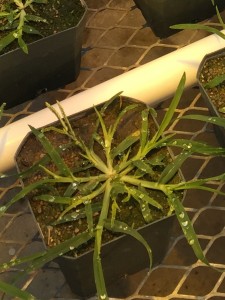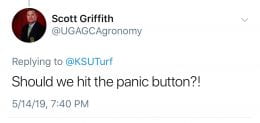(By Jared Hoyle, KSU Turfgrass Research and Extension)
Not too long ago I received a text from a friend of mine with a picture of goosegrass and the caption, “goosegrass emergence reported in Salina, KS in areas w/o PRE.” With the mild temperatures and just now seeing crabgrass germinate in some thin areas where no preemergence has been applied, I thought to my self, “Oh no.” I then posted the picture on Twitter to let everyone know what was going on in the area.
One of my good friends, Scott, down in Georgia commented “Should we hit the panic button?”
To answer that question honestly… I’m not sure. Then I went back and looked at the picture. There was a set of keys in the picture to help show the relative size of the goosegrass and on the key was a “panic” button that is commonly on keyless entry vehicles. Ironic?
So should we hit the panic button? I am not sure but I do think that means we need to keep an eye out and know that goosegrass is on its way if not already germinated and especially in areas that haven’t been applied with a preemergent herbicde.
 Goosegrass (Eleusine indica) is a summer annual weed that typically germinates after crabgrass in the spring. That is about when the soil temperatures consistently reach approximately 60° F. Like crabgrass, goosegrass is best controlled with a preemergence herbicide. Herbicides that contain the active ingredient oxadiazon work very well. Other preemergence herbicide efficacy can vary.
Goosegrass (Eleusine indica) is a summer annual weed that typically germinates after crabgrass in the spring. That is about when the soil temperatures consistently reach approximately 60° F. Like crabgrass, goosegrass is best controlled with a preemergence herbicide. Herbicides that contain the active ingredient oxadiazon work very well. Other preemergence herbicide efficacy can vary.
But as it seems like everyone has already put down preemergence herbicide so, you have nothing to worry about. Well what if you didn’t, or there is break through? There are some POST application control options.
First, Know you turfgrass species. Your herbicide selection is going to vary greatly depending on species.
If you have cool-season turfgrass then you can use fenoxaprop (Acclaim Extra), fluazifop (Fusilade II), topramezone (Pylex), or MSMA (golf courses and sod farms only!). You will probably have to do more than one application if the goosegrass is tillered out. Sulfentrazone (Dismiss) is also effective on goosegrass if it has not tillered out yet.

Creeping Bentgrass
For all you golf courses out there that have creeping bentgrass fairways it is going to be a little bit more difficult because the herbicides that work best tend to injure the turf. 1-Tiller or smaller can be controlled with fenoxaprop (Acclaim Extra) at 3.5 fl oz/A but you will need to re-apply every two weeks to make sure you are applying to small plants.
As crazy as it sounds a herbicide that has commonly been used for broadleaf weeds has shown control on goosegrass. SpeedZone (2,4-D +dicamba + MCPP) has shown control but a follow up[ application is going to be needed 30 days after initial application.
Topramezone (Pylex) can be used on bentgrass at lower rates (0.25 fl oz/A) but definitely might need a repeat application at 21 days
Bermudagrass and Zoysiagrass
Now if you have bermudagrass or zoysiagrass then you can use Tribute TOTAL (thiencarbazone + foramsulfuron + halosulfuron). Fusilade II and Acclaim Extra that works in cool-season grass can also be used on zoysiagrass. If you mix these products with triclopyr (Turflon Ester Ultra or Triclopyr 4) then you will get better results.
Always remember to READ THE LABEL for the correct rate, turfgrass tolerance, and specific instructions before application!!!
***Mention of trade names or commercial products in this article is solely for identification purposes and does not imply recommendation or endorsement, nor is criticism implied of similar products not mentioned by Kansas State University.***
Don’t forget to follow me on twitter @KSUTurf.
Also, visit our facebook page www.facebook.com/KSUTurf


